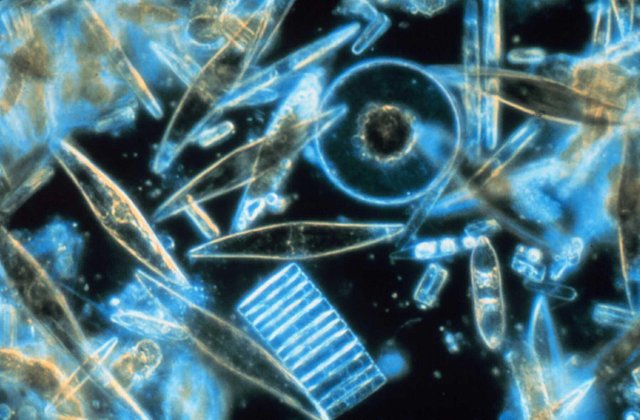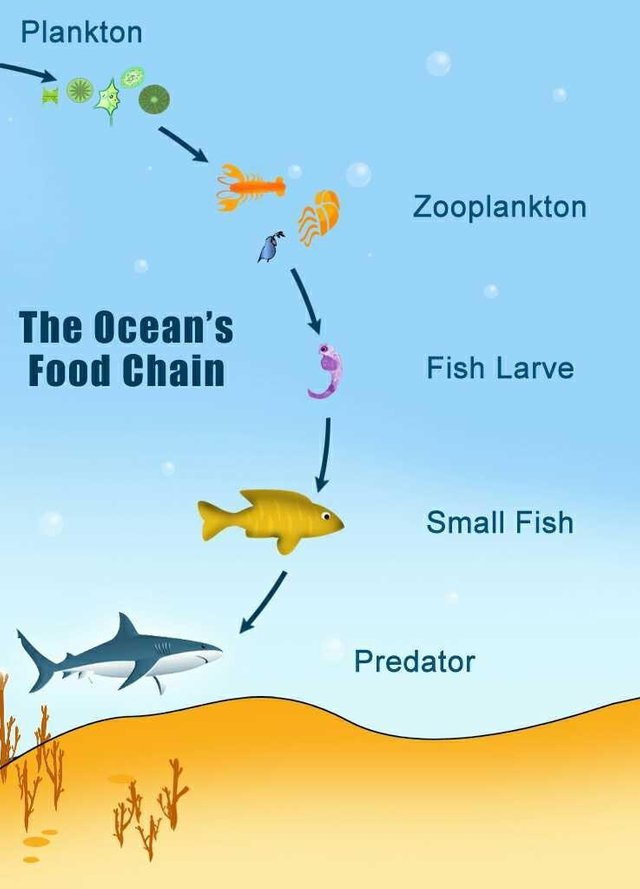The small ones that make the big difference - phytoplanktons.
INTRODUCTION
We are made up of complex interactions of various activities. Some of which we do consciously and others that we do without necessarily thinking about. One of such activities that we perform without thinking about is breathing. No one thinks before they breathe except they have some serious medical conditions that make breathing difficult. Breathing is one of the most important processes that take place in man as well as other living things. It is controlled by the part of the brain known as the medulla oblongata. Breathing like other involuntary actions take place without you consciously trying to control the process. Breathing involves the exchange of air; taking in oxygen into the lungs while releasing carbon dioxide as an end product of respiration.

modified from original image - public domain: Wikipedia image
Breathing is a needed for respiration to be completed and it has to do with the taking in of oxygen and giving out carbon dioxide which is the end product of respiration. Respiration is a complex reaction that involves the breaking down of glucose using the oxygen inhaled to break down glucose to produce energy. This takes place every moment of our lives that we seldom take note of it. Oxygen is used for respiration and it is also very reactive. This means that oxygen is being constantly removed from the atmosphere and also very reactive we cannot be sure it will continuously be available in its useful state. Therefore, there is a need to constantly replenish this oxygen being used by man, the birds, the rodents, the lion, and even the fish in water. All thanks to photosynthesis, a process by which green plants manufacture their own food, oxygen is supplied back to the atmosphere while carbon dioxide is used up in the process. The cycling of both gases is controlled mainly by respiration and photosynthesis.
Oxygen is abundant in our atmosphere, about 21% in volume. It is a colourless, odourless and tasteless gas. Oxygen is an element with the atomic number of 8 but too reactive that you don't usually find it in its free state. It can react with almost all the other elements and found in a combined state with them as oxide. The oxygen in the atmosphere is formed by the combination of two atoms of oxygen to form the diatomic gas written as O2. , on the other hand, is less than 1% volume of the atmosphere. It is made up of 1 carbon atom and 2 oxygen atoms. In chemistry, it is written as CO2. If our body is to be separated by the chemical elements that can be found in it, carbon will be the second most abundant element. CO2 happens to be the most important source of this carbon to us. During photosynthesis (which I explained better later in this post), plants make use of the gas to produce glucose and they serve as the base of every food chain.
What are the small ones and what difference do they make?
 Diatom. Public domain: Wikipedia image
Diatom. Public domain: Wikipedia image
What are phytoplankton?
Phytoplanktons can best be described by explaining the name itself. Let me start by splitting the name into parts, ‘phyto' and ‘plankton'. The name plankton describes those aquatic organisms that cannot swim at their own will. Their movement simply depends on the water current. The Greek word for planktons means drifter. While the Greek word for ‘phyto' simply means plant. This should give you an idea of what these organisms are. They are the photosynthetic free-floating aquatic organisms and are usually microscopic which means you don't always get to see them like your garden plants. However, when conditions are very favourable and these organisms bloom, they may appear greenish on the surface of the water due to the presence of the green pigment – chlorophyll in their cell component. They also serve as the base of the oceanic food chain. The zooplankton feed on them and smaller organisms can feed on both the zooplankton and phytoplankton and larger organisms will then in turn feed on these smaller organisms.My teacher once said jokingly that if you can imagine a shape then there is probably a plankton that looks like that. They are abundant and of diverse form inhabiting the surface of the water where sunlight penetration can reach as it is needed for photosynthesis to take place. Along with the light energy obtained from sunlight for photosynthesis, phytoplankton needs nutrients like nitrogen and phosphorous from the water for their growth. There are three major groups of phytoplankton which I will briefly highlight.
- The blue-green phytoplankton also known as the cyanobacteria can occur either as single-celled or filament and also can come together to live as a colony.
- The planktonic green algae also are known as the Chlorophyceae is also another important group of planktons. They are also mostly cultured as food for zooplankton in feeding fish larvae. Also, they are more of freshwater than the marine waters.
- The diatoms which are the third major group is also an important group of phytoplankton. According to live science, diatom contributes 20% of the oxygen we breathe. This is indeed a small organism with a big difference in my own opinion. Another characteristic worth knowing about them is their cell wall made of silicate.
- There are other examples of phytoplankton that do not fall into these major categories such as the dinoflagellates, the brown algae, the red algae, and etcetera.
Oxygen production by phytoplankton through photosynthesis
Phytoplanktons, like plants, are autotrophs which means they produce their own food through the process of photosynthesis. Their cell consists of a green pigment known as chlorophyll. It serves the function of trapping solar energy from sunlight. The phytoplankton gets the needed water for photosynthesis by absorbing water from their environment and the carbon dioxide from the atmosphere produced which can be an end product of respiration or released during decay or decomposition. This process results in the production of glucose and oxygen gas. Although these organisms are individually very small, they collectively contribute immensely to the oxygen equilibrium. The equation below illustrates the process of photosynthesis in a plant:
6H2O + 6CO2 + Light energy ---> C6H12O6 + 6O2
The same equation written in words only is shown below
Water + Carbon dioxide + Light energy ---> Glucose + Oxygen
Biological pump, an action influenced by phytoplankton
 biological and physical pump of carbon dioxide : Creative Commons
Attribution-Share Alike 2.5 Generic
biological and physical pump of carbon dioxide : Creative Commons
Attribution-Share Alike 2.5 Generic
Primary productivity in the ocean by phytoplankton
Although the process of primary productivity by these organisms have been highlighted in the explanation of photosynthesis above, it is important to note that this organism makes it possible for production to take place in the ocean. Although not all fish feeds on the phytoplankton, they ultimately rely on them to obtain their own food. And even some big ocean dwellers feed on these tiny organisms. Take for example, the baleen whale whose feeding preference includes the planktons. The phytoplankton are fed on by the zooplankton and those are in turn fed on by smaller fish and the process continues where the smaller ones are eaten by the bigger ones. This, however, will be determined by the feeding habit of the individual organism and not necessarily their size.Reference
- https://en.m.wikipedia.org/wiki/Oxygen
- https://en.m.wikipedia.org/wiki/Phytoplankton
- https://en.m.wikipedia.org/wiki/Biological_pump
- Marine Plants: A Unique and Unexplored Resource
- Source of Half Earth's Oxygen Gets Little Credit
- The Air You're Breathing? A Diatom Made That
- Importance of phytoplankton
 file available under
file available under
This post has been voted on by the SteemSTEM curation team and voting trail in collaboration with @curie.
If you appreciate the work we are doing then consider voting both projects for witness by selecting stem.witness and curie!
For additional information please join us on the SteemSTEM discord and to get to know the rest of the community!
Phytoplanktons are very important to life on earth because they are the primary food source in the food chain and support in the release of oxygen in the atmosphere. Human activities that lead to Ozone layer depletion pose a massive risk to them, which is why everyone should be watchful of the products they buy and farmers should be mindful of the fertilizers they use.
I was indeed about to comment with something similar. Global warming are endangering planktons, and therefore the entire reign of living beings...
Thanks for your contributions. If everyone is aware of how important these tiny organisms are, I'm sure they'll be more cautious of how they treat the environment.
Posted using Partiko Android
Hello! I find your post valuable for the wafrica community! Thanks for the great post! We encourage and support quality contents and projects from the West African region.
Do you have a suggestion, concern or want to appear as a guest author on WAfrica, join our discord server and discuss with a member of our curation team.
Don't forget to join us every Sunday by 20:30GMT for our Sunday WAFRO party on our discord channel. Thank you.
Congratulations! Your post has been selected as a daily Steemit truffle! It is listed on rank 12 of all contributions awarded today. You can find the TOP DAILY TRUFFLE PICKS HERE.
I upvoted your contribution because to my mind your post is at least 6 SBD worth and should receive 188 votes. It's now up to the lovely Steemit community to make this come true.
I am
TrufflePig, an Artificial Intelligence Bot that helps minnows and content curators using Machine Learning. If you are curious how I select content, you can find an explanation here!Have a nice day and sincerely yours,

TrufflePigCongratulations @mr-aaron! You have completed the following achievement on the Steem blockchain and have been rewarded with new badge(s) :
Click here to view your Board
If you no longer want to receive notifications, reply to this comment with the word
STOPThank you so much for sharing this amazing post with us!
Have you heard about Partiko? It’s a really convenient mobile app for Steem! With Partiko, you can easily see what’s going on in the Steem community, make posts and comments (no beneficiary cut forever!), and always stayed connected with your followers via push notification!
Partiko also rewards you with Partiko Points (3000 Partiko Point bonus when you first use it!), and Partiko Points can be converted into Steem tokens. You can earn Partiko Points easily by making posts and comments using Partiko.
We also noticed that your Steem Power is low. We will be very happy to delegate 15 Steem Power to you once you have made a post using Partiko! With more Steem Power, you can make more posts and comments, and earn more rewards!
If that all sounds interesting, you can:
Thank you so much for reading this message!